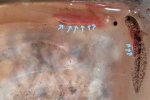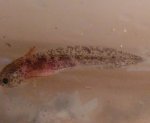tgmiller
New member
- Joined
- Jan 25, 2018
- Messages
- 9
- Reaction score
- 0
- Points
- 0
- Location
- South Dakota, USA
- Country
- United States
I have been reading through previous posts on "floating" juvenile axolotls for the past couple of months and, after joining as a member of caudata, I have even posted some of my own personal experiences with floating juveniles in order to try and help others.
The problem is, most of my experiences have been failures. I am currently raising approximately 220 juvenile axolotls. It has been about 7 weeks since they have hatched, and in the first few weeks I would go to do their daily water changes and find almost half of them floating upside down! At first, I panicked. This is my first time hatching and raising axolotls (turns out axolotls can breed before they are even 8 months old) and I thought they were all dying. I did some reading on caudata and it turns out that this wasn't completely abnormal for newly hatched axolotls. Thankfully, at least in my case, I would have 30-50 floating on any given day for the first few weeks but I only lost 2 or 3 in total during this period of time. And this wasn't necessarily because of the floating issue.
After the first 2 or 3 weeks I went without any issues with floating axolotls until about week 5 or 6. Since then I have lost close to 10 axolotls due to floating/bloating and have had only 2 or 3 others recover. I cannot figure out what is causing this. So far it has only occurred in my smaller juveniles that are still eating live brine shrimp only and in some that are eating a mix of live brine shrimp and frozen blood worms. Am I getting too many unhatched brine shrimp eggs in with my hatched brine shrimp? Could that possibly be what is causing this? I don't know what else it could be or if it's just something that unfortunately happens naturally that I have no control over? I apologize for the long post but I would appreciate input from anyone who has any advice from their own trial and errors with this problem or who has read any helpful posts or articles regarding this issue.
I have attached a few images of two of my juvenile axolotls that I am currently trying to get through this issue. I still have hope for them, the wild one especially, as they are still floating on their sides and the bubbles are still small and separate instead of merging into one large air pocket. So far I have lost every one of my juveniles that the air bubbles have merged into one and they go from floating on their side to completely upside down.
Thank you to everyone who has read this post to the end. Any and all advice and constructive criticism is greatly appreciated.
The problem is, most of my experiences have been failures. I am currently raising approximately 220 juvenile axolotls. It has been about 7 weeks since they have hatched, and in the first few weeks I would go to do their daily water changes and find almost half of them floating upside down! At first, I panicked. This is my first time hatching and raising axolotls (turns out axolotls can breed before they are even 8 months old) and I thought they were all dying. I did some reading on caudata and it turns out that this wasn't completely abnormal for newly hatched axolotls. Thankfully, at least in my case, I would have 30-50 floating on any given day for the first few weeks but I only lost 2 or 3 in total during this period of time. And this wasn't necessarily because of the floating issue.
After the first 2 or 3 weeks I went without any issues with floating axolotls until about week 5 or 6. Since then I have lost close to 10 axolotls due to floating/bloating and have had only 2 or 3 others recover. I cannot figure out what is causing this. So far it has only occurred in my smaller juveniles that are still eating live brine shrimp only and in some that are eating a mix of live brine shrimp and frozen blood worms. Am I getting too many unhatched brine shrimp eggs in with my hatched brine shrimp? Could that possibly be what is causing this? I don't know what else it could be or if it's just something that unfortunately happens naturally that I have no control over? I apologize for the long post but I would appreciate input from anyone who has any advice from their own trial and errors with this problem or who has read any helpful posts or articles regarding this issue.
I have attached a few images of two of my juvenile axolotls that I am currently trying to get through this issue. I still have hope for them, the wild one especially, as they are still floating on their sides and the bubbles are still small and separate instead of merging into one large air pocket. So far I have lost every one of my juveniles that the air bubbles have merged into one and they go from floating on their side to completely upside down.
Thank you to everyone who has read this post to the end. Any and all advice and constructive criticism is greatly appreciated.


